Rindskopf Pepita - Not the Marker Decor We Thought
by Craig Orkney
This information was originally posted on the internet in June of 2015 in a collector forum, and has
since been removed from that forum to be posted here.
What collecting and researching Bohemian/Czech glass has taught me through the years, is that so often commonly accepted concepts are not as they appear when examined closely. Additionally, I have learned that a new piece of evidence found out of the blue, can easily change an idea or concept overnight, even though the question it helps to answer may have been examined for years. It has also taught me that questioning "commonly accepted facts" occasionally leads to new information or ideas. Most importantly it has taught me that as soon as one stops asking questions and simply accepts the Status Quo, our knowledge stagnates, and the new questions we are not asking will never be answered.
As an example, a concept such as "Who marked Czech glass for export?" is a question which seems on the face so simple and reasonably unimportant, but in fact is an ideology which can have a great impact on how we look at and think about this glass. To me, exporters marking glass is a concept which makes little sense, and I posted my thoughts on why I think that. The concept that they did, if just blindly accepted, does allow us to ignore export marks while classifying them as "meaningless", and simultaneously allows us to ID glass based on commonly accepted "paradigms". It is for these reasons that I ask the "questions" I do, and when I ask, I invest a lot of my time and thought into understanding the question, and the premises of our currently accepted understandings. Sometimes they make sense to me and I move on. Other times they do not. When they don't, I ask "Why?", and the resulting conclusions are often "controversial".
To me collecting is really about the "appreciation and understanding" of the items we "gather" to admire. In this case that item is glass. Research it seems to me, is about "questions and knowledge", and is simply a tool through which we can gain additional information which will enhance the "appreciation and understanding" aspect of what we love to do.
So just for kicks, as a kind of "accepted concepts" exercise, and really only for the purpose of curiosity, let's look at what Truitt says regarding a decor matching the description of Pepita, as outlined in Truitt I pgs 118 & 119. In Truitt I there are two images of pieces of Rindskopf production seemingly matching the Pepita description. There are some examples which appear to be solid red, but for the moment we will simply ignore that. There is one image on pg 118 & one image on pg. 119. These two images are reproduced in the first picture above. Although I have not found an easy explanation why, Truitt refers to the decor we call Pepita, as Grenada. They also make a statement on pg. 118 that Rindskopf had decors named both Grenada & Pepita. It is also worth noting that the Passau seems a little unsure in their representation of Pepita in Das Bohmische Glas, as they also show examples of what we now call Grenada and caption them as "Pepita?".
So what we commonly accept as Pepita today was originally classified by Truitt as Grenada. When did it switch to being called Pepita, and why? A recent email with Deb Truitt provided no real clues, as did conversations with several researchers whose opinions I value greatly. There seems to be some possible explanations, but none are really quantifiable and clear, and none of them appear to be based on new research findings. The images from Truitt I are shown below.
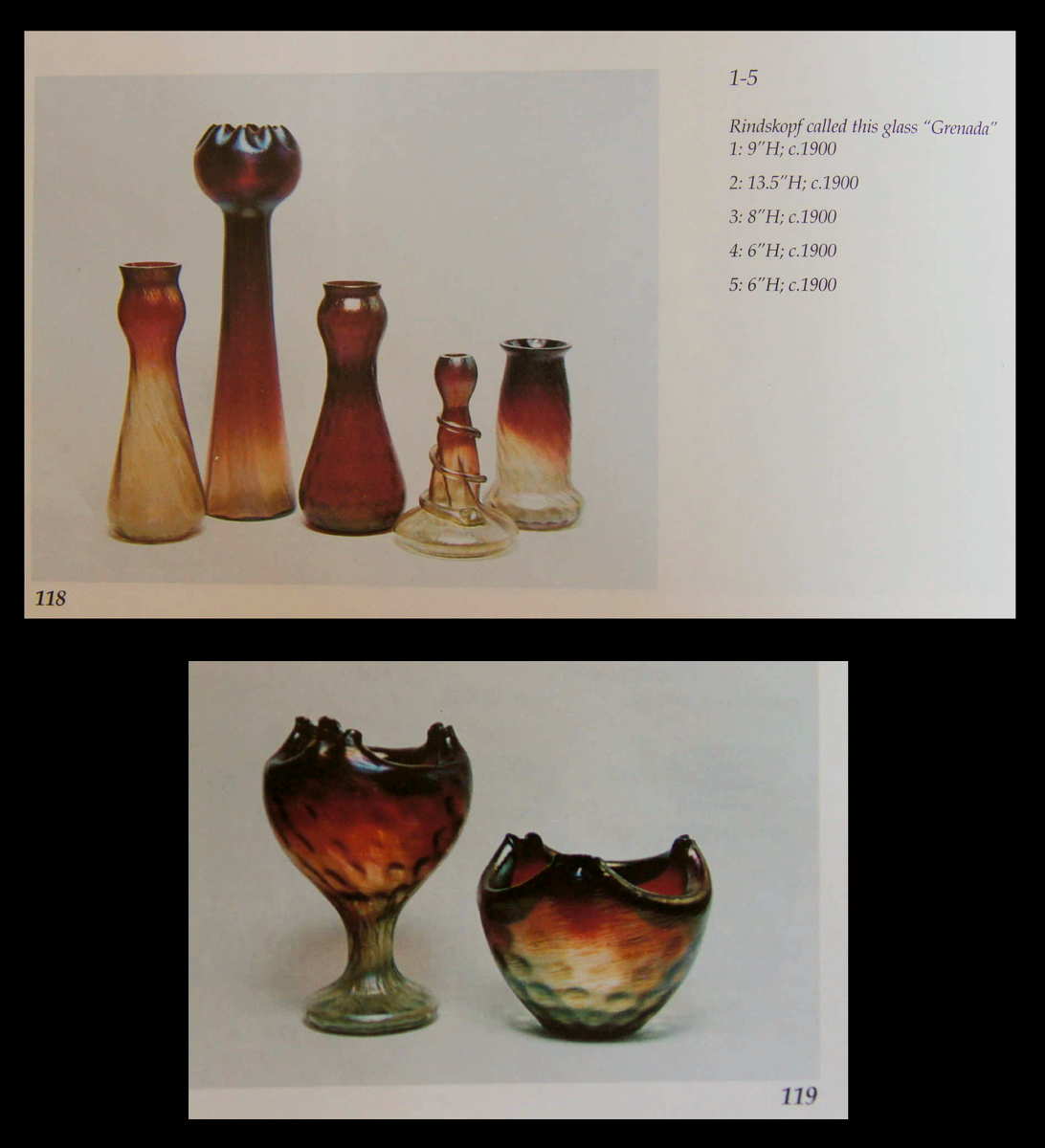
Interestingly, a Pepita is a seed from the pumpkin which is orange. Grenadine is a syrup made from the dark red fruit of the Pomegranate. The French word for pomegranate is "Grenade". This would possibly also explain the solid dark red pieces we see in the larger group of "Grenada" in the Truitt image. Mean anything? Got me. So we now commonly accept that the dark red based decor is Pepita, but no one can really say why. Personally, I find that extremely intriguing!
But for now, let's move on and simply call the decor what we call it today, and that is Pepita. We will leave the question as to why we do that for another day.
So for the purpose of this post, let's start with some information. What I would call "givens". Givens in this case would be defined as "facts" which are commonly accepted in the world of glass collecting & research.
Givens
1) Pepita is a decor which is currently accepted as a vase having a Burgundy top which blends to a lighter base. The lighter base is covered with green Papillon, or spots of green. Both the shade of green and the amount of "spotting" can vary with pieces.
2) A "marker" decor is a decor which identifies production as being from a specific house, based on the "fact" that no other house produced the decor. Most manufacturers are considered to have at least a handful of markers, whether they be decors, shapes, or techniques.
3) Pepita, as described above, is currently considered to be a marker for Rindskopf production. In other words, if a vase is produced in the Pepita decor, then Rindskopf produced it.
4) Provenance marks are defined as marks placed on glass in order to meet import marking requirements for the country the glass is being exported to. In other words, it states the country of origin, but not the name of the maker.
5) Although there is some disagreement regarding whether exporters or manufacturers placed provenance marks on glass, there are two provenance marks which are commonly accepted as indicating house of manufacture for pieces with these marks. These marks are also considered to be marks applied by the corresponding houses, and not by an exporter or importer.
6) The accepted marks are the arched "Czechoslovakia" mark with "open" O's, which indicates the marked item was produced by Kralik. The other accepted mark is the oval used by Loetz.
Over time I had become disillusioned with the Pepita decor being used and recognized
as a commonly accepted marker for Rindskopf production.
Most that know me well, know I am simply not one that accepts what I am told without question because of who told me. I may be stubborn, but I kind of like to be shown some evidence to support "iron clad" statements. I have said this before, and will continue to state it without hesitation. I am not of the opinion that I am always 100% correct. I have made mistakes and openly admitted them when I made them. I also openly state when I do not know something. I also will ask for supporting evidence when someone tells me something and tells me that it is "without doubt". Without a doubt always makes me sit back for a second and go "Really??... No way it could be something different? Most of the time it can't be something different, but sometimes it appears that it can.
So let's look at image directly below. In this image we see 4 shapes, all in the molded web decor, which I initially considered to be by an unknown house. I later changed that opinion to it being a Rindskopf decor. What most people will see on one of each of the 4 shapes is also "Rindskopf Pepita". Since the shapes were reasonably distinctive, and the surface decor on all of the examples was the same decor, I can see how someone would be inclined to conclude the production is Rindskopf. I originally thought so myself based on the understanding that the Pepita decor was a Rindskopf marker. These 4 vases certainly appeared to meet the stated description of Pepita as described above.
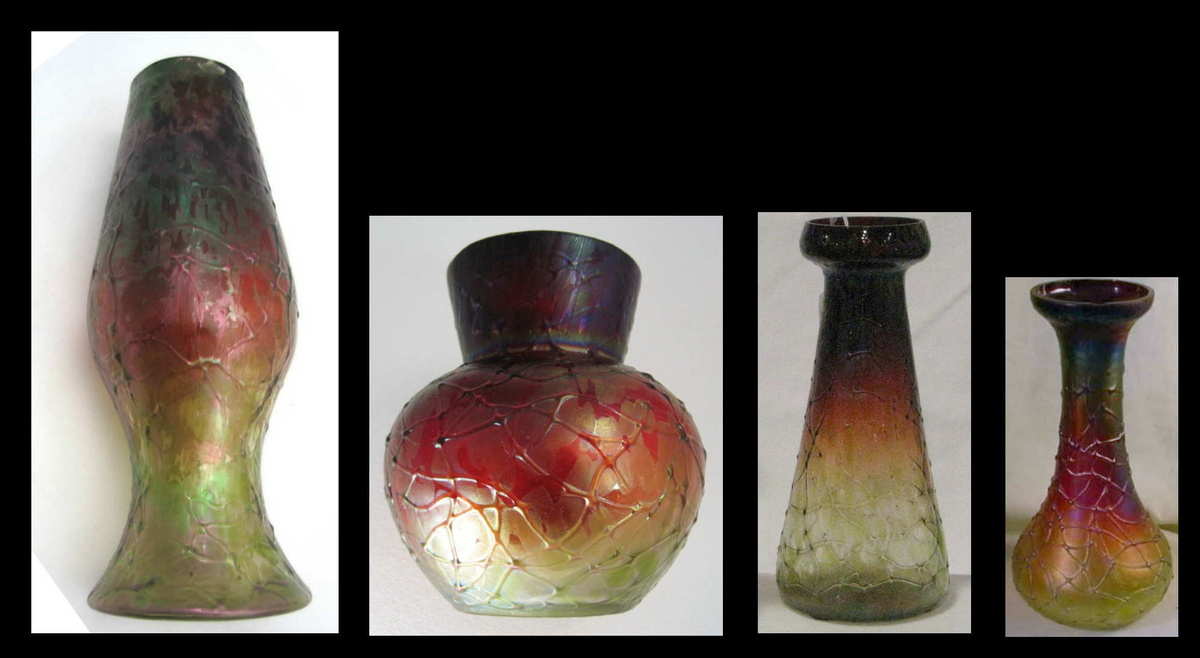
Now, on a slightly different, but related subject, I have a good friend who collects Rindskopf and other glass. She is particularly enamored with Rindskopf though. Amongst the different things she has studied in glass, has been a similar shape basket, produced by Loetz, Kralik, and Rindskopf. All three houses made a similar shape in their own decors, or so it seemed. By studying these baskets she has made a series of observations. Amongst those observations is that the houses appear to use different prunts on the spot where the handle attaches to the body of the basket.
As she collected examples and images of recognized decors, one observation that confused her, unbeknownst to me at the time, was that there were some Pepita baskets that had a style of prunt seen on Kralik baskets she was able to identify. Confusing to her, but at the time not a reality shattering observation.
I also saw a tall pierced vase in a shape recognized as Kralik production. Many of the known examples of the shape are in pearlescent and colored glass and were produced by Kralik as blanks for Hosch. Along comes this lone example in Pepita, and the sky was falling... What? How could this be? A marker Kralik shape in a marker Rindskopf decor... Migrating production workers? Shared Orders? A single aberration which no one could explain.... And it was left as the great unknown. This example is in the image below, along with an image of Kralik opalescent punched examples refined by Hosch. These are shown in Truitt I, pg 77, upper left image. There are other examples of punched pieces by Kralik shown on this webiste under Kralik "Punched" in the Kralik Visual Decor Index.
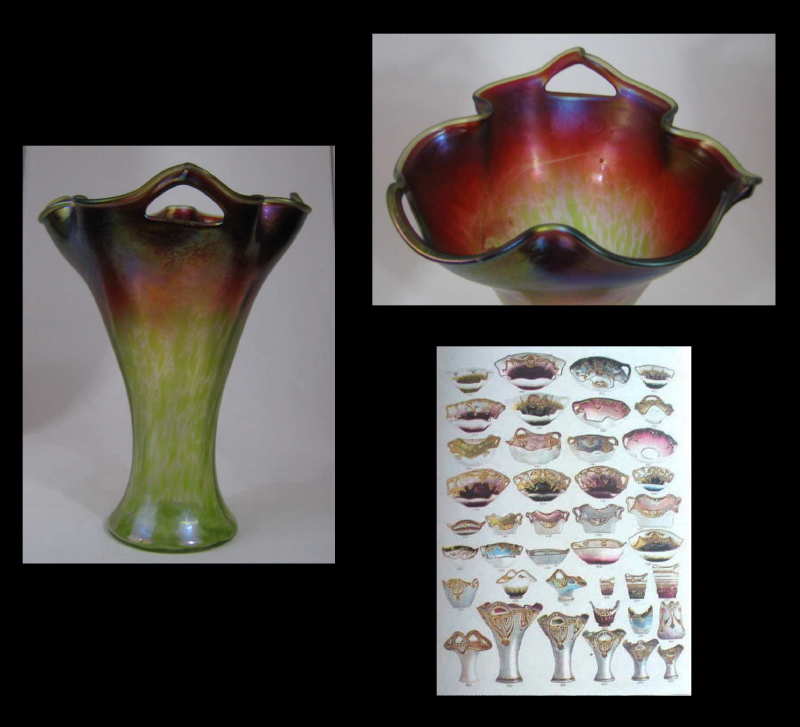
The image below shows the bottom of a spatter vase on the top left hand side with the vase directly below it. It is clearly marked with an arched Czechoslovakia mark with open O's. It is also the first example of this decor I have ever located with an identifying mark of any kind. Based on the current accepted "paradigm", the vase in question would be an example of Kralik production. A fairly distinct shape displaying an obviously distinct surface decor. Directly to the right we see a grouping of that style of vase. Is that a Rindskopf Pepita there? Some would say "Yes, of course it is".
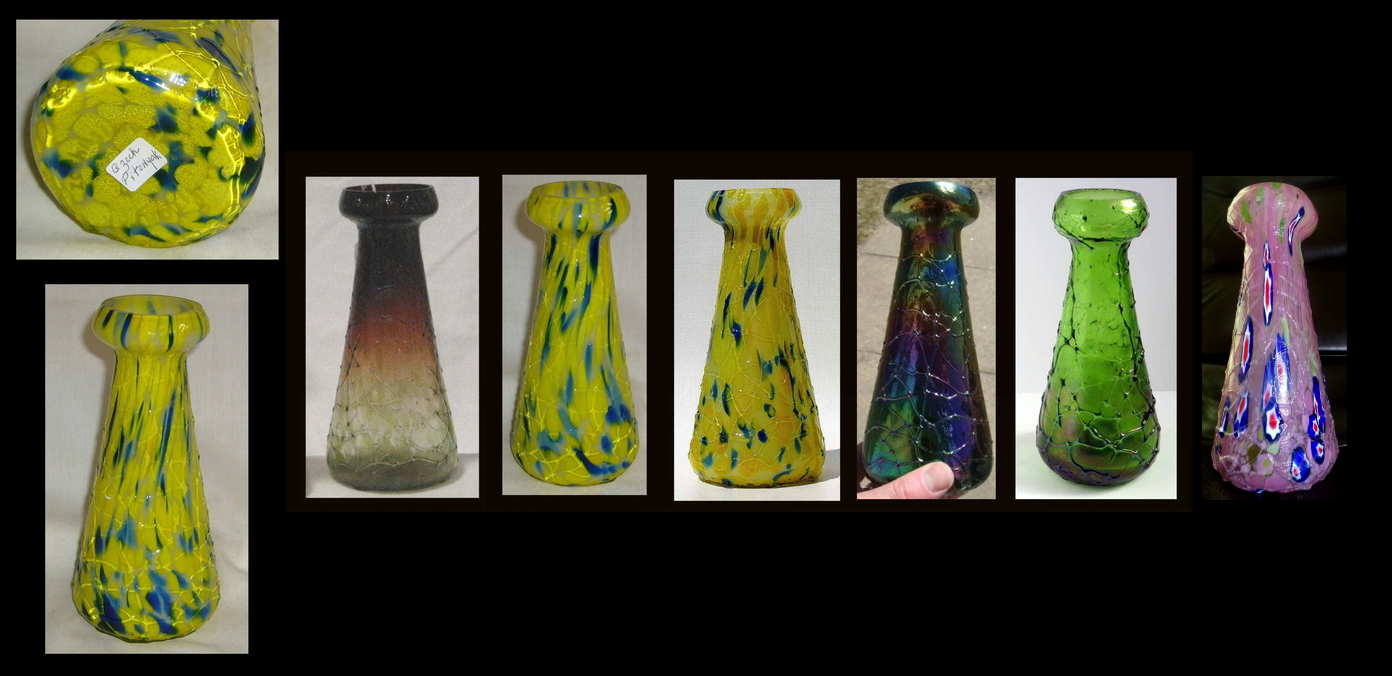
But that is not what I now see. I see a series of vases, which if you ignore the Pepita decor, are of a common manufacture based on some similar grounds, common shapes, and a pretty distinctive molded web decor. I see a marked example which indicates Kralik production, and as a result I see a decor we call Pepita, which at least to me, can not be used as a reliable marker for Rindskopf production any longer.
I also see a reasonable explanation for the punch handled vase which was so confusing. Simple answer, possibly produced by Kralik in a "decor shift" of Pepita. Lastly, this would also provide a basis for the fact that my friend saw confusing baskets in Pepita with a Kralik handle prunt. Simple answer... Kralik also produced the decor, and did it so well that many, myself included, were fooled when evaluating the production.
The left side of the image below shows 4 shape groups I have studied. On the right side we see some examples which I think need at the least, some serious consideration. Am I saying all of these are not Rindskopf? No, but I am suggesting that they deserve a hard second look. The upper two images show a handle prunt found on baskets. The left side is a Kralik style prunt, which some would call a raspberry prunt. On the right side is a kind of sliced pie looking prunt found on Rindskopf baskets. The Kralik example is on a basket seen below it which has been previously identified by others as a Rindskopf Pepita basket. This example also shows some of the traits, in the body of the basket, of a decor Kralik referred to as corrugated. Both Kralik and Rindskopf made a corrugated decor. The Rindskopf prunt example is from a basket in the Grenada decor. The Pepita basket below it with silver overlay has the same prunt. To the right of those pieces is an example of a vase in what appears to be a Pepita like decor. In many other decors, this vase would most likely be attributed by many to Kralik. It is examples such as this one that I feel we need to exercise caution in attributing based on the "Pepita" decor. The bottom row of images shows a crimped fan vase, previously identified as Rindskopf in the same variation of Pepita as seen on the basket above it. To the right of that we find a Kralik threaded crimped vase which has a Kralik arched mark. My point in showing these images is to simply demonstrate that if we continue to use Pepita as a marker decor for Rindskopf, that we may end up with a string of compounded errors, starting with what I now consider to be an avoidable mistake.
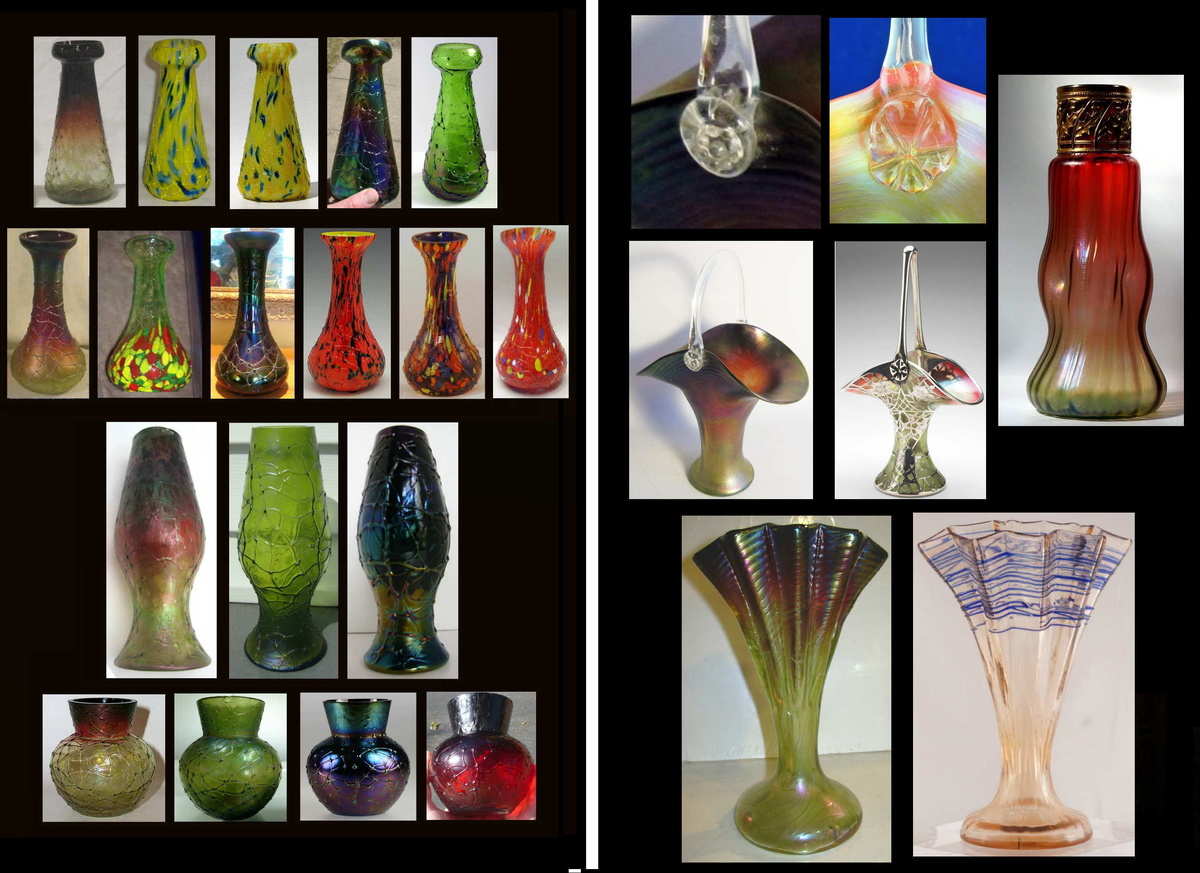
As a last piece of evidence which I believe supports my finding that Pepita can no longer be deemed a marker decor for Rindskopf, I provide the last image below. In this image we see a grouping of vases in a common shape. These vases were offered in a Quittenbaum auction, in what was one of the largest offerings of Pallme Konig production ever seen. The top image is an example of this shape in a decor which could easily be mistaken for the "Pepita" decor, resulting in the misclassification of this example as Rindskopf production. The decor and vase are both Pallme Konig production. In this case we see an example of a third house producing a decor with a strong resemblance to Pepita, providing even more evidence to support my findings that Pepita can not be used in this manner any longer.
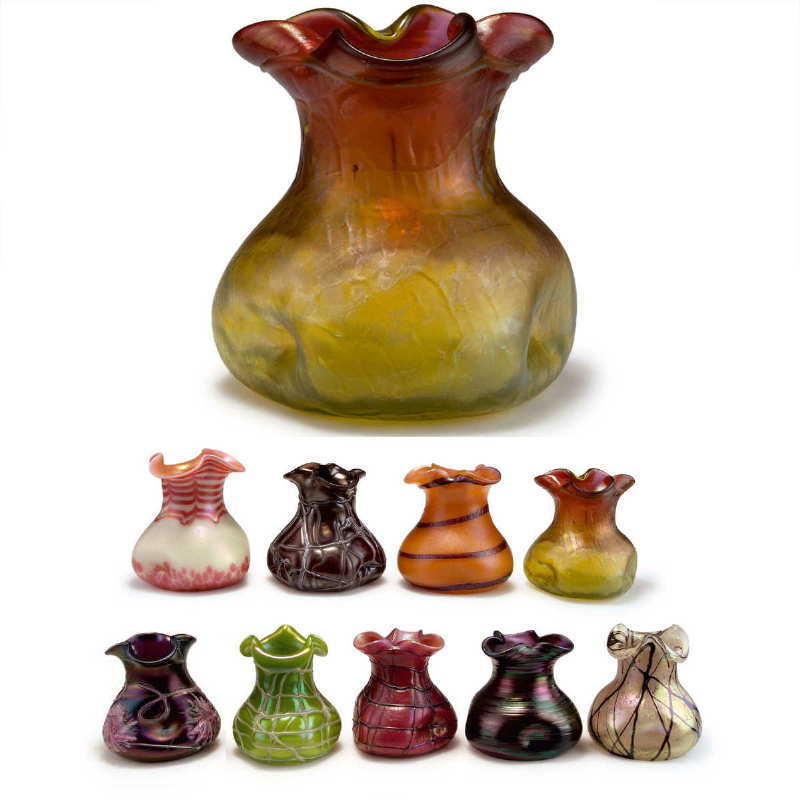
Conclusions:
1 - It appears, at least to me, that the Pepita decor by Rindskopf was produced in a highly successful decor shift by Kralik, and that would preclude it from being used any longer as a marker for Rindskopf production. It also appears that at least to some degree, Pallme Konig also produced a similar decor to Pepita. Sure, Rindskopf likely made the majority of Pepita examples we will find, but certainly not all of them. This is supported by examples in images 2, 4, and 6 above.
2 - The "Pepita style" example as seen in both image 2 and image 4 above, taking into consideratin the marked example in image 4 in the same shape and surface pattern, is Kralik production.
3 - After years of looking at the subject, I have now changed from an initial belief that Rindskopf produced the "Molded Web" decor based on being found in "Pepita", to believing Kralik is the production house responsible for the "Molded Web" decor seen in a variety of shapes and grounds.